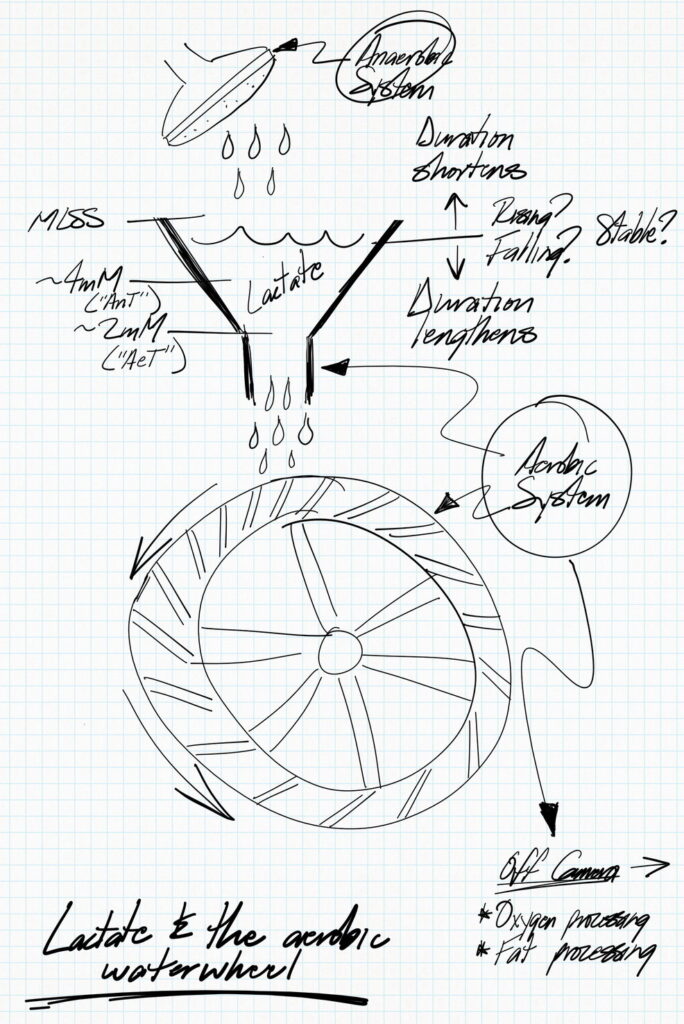You know what endurance is, right? It is the ability to maintain a high rate of work output for long durations, or some variation on that definition. But what enables endurance? Stated another way: What is it that powers the muscle contractions that propel you for hours of a climb or race? The answer can be stated in three letters: ATP.
The molecule ATP provides the energy for movement and is the product of metabolic processes in the muscles. Training for endurance is simply an organized method to enhance your metabolism, or, in other words, to increase your muscles’ rate of ATP production.
Metabolism itself can be described simply as the process whereby the energy in the food you eat is used to construct ATP molecules, which are broken down to fuel muscle contractions (among many other cellular functions) before the post-metabolic component molecules are reassembled into fresh ATP molecules.
ATP: Adenosine Triphosphate
If any one molecule can be singled out for its life-giving force, ATP is it. It truly is what allows life to be. ATP is a short-term energy storage molecule used by every cell in your body. The energy released when ATP’s chemical bonds are broken is what powers the functions of cellular life.
Most important for athletes, this energy is used to power muscular contractions, hence, movement. To avoid running out of ATP, you might expect that we need a huge reservoir of the stuff. We would … if our cells didn’t have their own recycling mechanisms built right inside each one. Because of this efficient recycling process we neither need nor have much of a store of ATP. Instead, after its bonds are broken and the energy released for our muscles to use, ATP is resynthesized from its component parts.
This recombination of ATP requires energy that is supplied by food you eat. The faster your muscles can resynthesize ATP, the more work you’ll be able to do in a given time. This is the goal of all endurance training: to make you go faster for longer. For this reason we’ll look at endurance as a direct result of metabolism.

Fuels for Energy: Metabolism and ATP
We utilize two distinct metabolic pathways for the production of ATP. The first is known as the anaerobic pathway because it does not require oxygen to proceed. It can only utilize glucose as a fuel source so is also termed anaerobic glycolysis. Glucose derives from the carbohydrates in your diet. The second pathway requires oxygen so it is known as aerobic metabolism. It can utilize fats, sugars, and proteins as fuel sources, also from the food you eat.
More ATP = more power.
Note that what follows is a very simplified explanation of a very complex series of processes and is not meant as a rigorous look at either ATP production or metabolism. It is meant to serve as primer for a basic understanding.
The Aerobic System
As long as the demand for ATP is low enough, the bulk of the energy will be supplied via the aerobic pathway. It is so named because the chemical reactions require oxygen to proceed. Fuel for aerobic metabolism can come from fats, sugars, and protein. The aerobic system is rate limited in its production of ATP so can only fully meet the energy demands of relatively low-intensity exercise.
In fact, one of the principal intensity markers is the capacity of the aerobic system to provide the bulk of the ATP needed. Exercise scientists call this the Aerobic Threshold (AeT). When that aerobic capacity is exceeded, the anaerobic system begins to contribute to the overall demands for ATP. Since the aerobic path can utilize all different fuel sources (carbohydrate, fat, and protein) and the body’s store of fats is many times that of sugar storage, aerobic fat metabolism will dominate as the fuel of choice in well-endurance-trained athletes, especially in events lasting over 2 hours.
This concept is of particular importance and will be discussed and dissected in numerous other ways.
Aerobic fat metabolism will dominate as the fuel of choice in well-endurance-trained athletes, especially in events lasting over 2 hours.
The Anaerobic System
When aerobic metabolism can no longer meet the ATP demands of the muscles, anaerobic metabolism (glycolysis) jumps in to make up the shortfall in ATP.
Anaerobic metabolism does not require oxygen (hence the name) but it can only utilize sugars for fuel. Once past the aforementioned AeT, the anaerobic ATP contribution will climb exponentially along with the intensity of the exercise. This is the high-power metabolic pathway and is what fuels those impressive feats of speed, especially in events lasting less than 2 hours. Its output is limited by the athlete’s anaerobic capacity.
This process has a drawback that makes the anaerobic output self-limiting for endurance events (defined as anything over 2 minutes). That limiter is the production of lactate (which is a by-product of anaerobic glycolysis). Lactate production rises at an ever-accelerating rate along with intensity. On the ascending scale of intensity, once you cross your Maximum Lactate Steady State (MLSS for short, is also known by several additional names, listed as a footnote*), the duration of exercise will be reduced to a few minutes at most due to fatigue. All endurance athletes have experienced the fatigue that comes on when the pace is too fast for too long. The only option is to slow down.
This form of fatigue is due to a reduction in ATP output by that very same anaerobic pathway. That drop in ATP production is prompted by the accumulation of hydrogen ions along with the lactate in the blood.

Lactate is a fuel for the aerobic system. Read more about its role in aerobic training.
The Metabolic Key to Unlocking More Endurance
For short-to-medium-length events (2 minutes to 2 hours) endurance athletes are most limited in their endurance by the ability to deal with this type of fatigue. If you can reduce the accumulation of lactate and the hydrogen ions, you will be able to delay the onset of this fatigue.
It turns out that you can’t do much to lessen lactate production since it correlates with the higher-power glycolysis. However, the rate at which lactate can be removed from working muscle is a highly trainable quality. Hence: The rate at which lactate can be taken up by the muscles as fuel is what determines your endurance. Lactate (being a form of sugar) can be utilized by the skeletal muscles, the heart, and the liver for energy. This point (as measured by speed or power or heart rate) where lactate production exceeds removal has been shown in multiple studies to correlate very closely to endurance performance.
How do you improve that lactate removal rate? Counterintuitively, as it turns out. The greatest reservoir for the lactate that high power output is producing is in the lowly, aerobically powered slow twitch muscle fibers. For these fibers, lactate is a preferred fuel. The greater the aerobic capacity of your slow twitch muscle fibers, the more lactate that can be removed.
You have no doubt heard the various terms of adulation heaped on great endurance athletes: “So-and-so has a great aerobic base” or “She has a really big motor.” Well now you know what that refers to from a muscular and metabolic standpoint. Here is the counterintuitive rub: To improve your higher-intensity endurance, you must first make sure you have maximized the aerobic capacity of those unsexy low-intensity, low-power slow twitch fibers.
It’s not as simple as only doing tons of long, easy distance, though. But you need that foundation to build a big motor. Once you maximize your aerobic capacity for a training cycle, you can use high-intensity work to its fullest to make the greatest gains in endurance.
*Lactate Threshold, Anaerobic Threshold, Maximum Lactate Steady State, Onset of Blood Lactate Accumulation, and Functional Threshold are all names for essentially the same metabolic event, where lactate production exceeds its rate of removal. Physiologists love to split hairs of the various definitions, but for our purposes here they all represent the point beyond which exercise can only be sustained for a short period.

